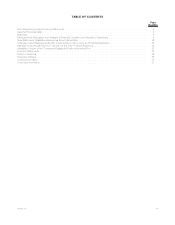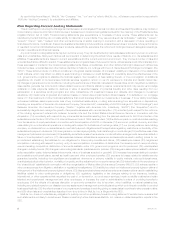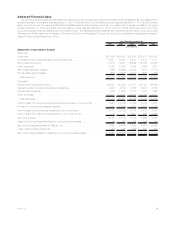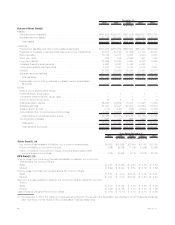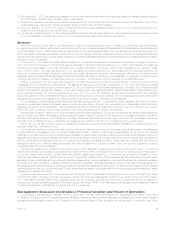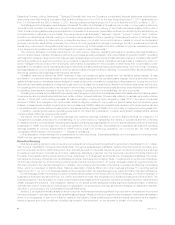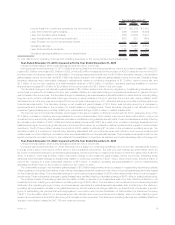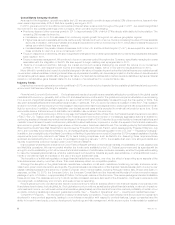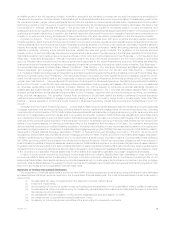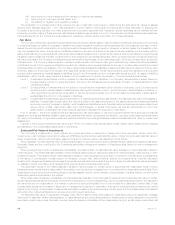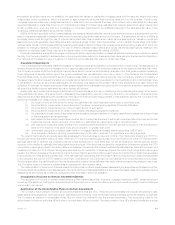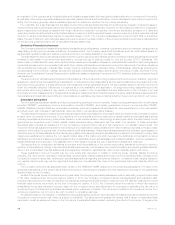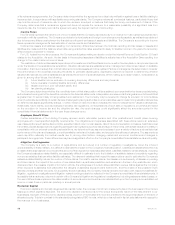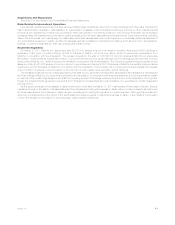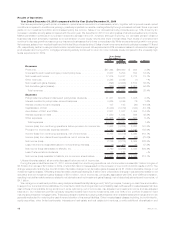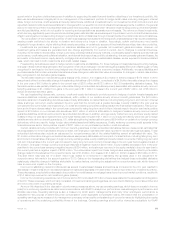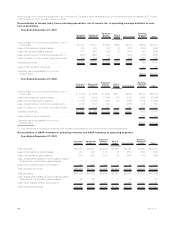MetLife 2010 Annual Report Download - page 14
Download and view the complete annual report
Please find page 14 of the 2010 MetLife annual report below. You can navigate through the pages in the report by either clicking on the pages listed below, or by using the keyword search tool below to find specific information within the annual report.are backed by similar loans are not available, the estimated fair values of residential mortgage loans held-for-sale are determined using
independent broker quotations, which is intended to approximate the amounts that would be received from third parties. Certain other
mortgage loans have also been designated as held-for-sale which are recorded at the lower of amortized cost or estimated fair value less
expected disposition costs determined on an individual loan basis. For these loans, estimated fair value is determined using independent
broker quotations or, when the loan is in foreclosure or otherwise determined to be collateral dependent, the estimated fair value of the
underlying collateral estimated using internal models.
MSRs, which are recorded in other invested assets, are measured at estimated fair value and are either acquired or are generated from the
sale of originated residential mortgage loans where the servicing rights are retained by the Company. The estimated fair value of MSRs is
principally determined through the use of internal discounted cash flow models which utilize various assumptions. Valuation inputs and
assumptions include generally observable items such as type and age of loan, loan interest rates, current market interest rates, and certain
unobservable inputs, including assumptions regarding estimates of discount rates, loan prepayments and servicing costs, all of which are
sensitive to changing markets conditions. The use of different valuation assumptions and inputs, as well as assumptions relating to the
collection of expected cash flows, may have a material effect on the estimated fair values of MSRs.
Financial markets are susceptible to severe events evidenced by rapid depreciation in asset values accompanied by a reduction in asset
liquidity. The Company’s ability to sell securities, or the price ultimately realized for these securities, depends upon the demand and liquidity in
the market and increases the use of judgment in determining the estimated fair value of certain securities.
Investment Impairments
One of the significant estimates related to available-for-sale securities is the evaluation of investments for impairments. The assessment of
whether impairments have occurred is based on our case-by-case evaluation of the underlying reasons for the decline in estimated fair value.
The Company’s review of its fixed maturity and equity securities for impairments includes an analysis of the total gross unrealized losses by
three categories of severity and/or age of the gross unrealized loss, as described more fully in Note 3 of the Notes to the Consolidated
Financial Statements. An extended and severe unrealized loss position on a fixed maturity security may not have any impact on the ability of
the issuer to service all scheduled interest and principal payments and the Company’s evaluation of recoverability of all contractual cash flows
or the ability to recover an amount at least equal to its amortized cost based on the present value of the expected future cash flows to be
collected. In contrast, for certain equity securities, greater weight and consideration are given by the Company to a decline in estimated fair
value and the likelihood such estimated fair value decline will recover.
Additionally, we consider a wide range of factors about the security issuer and use our best judgment in evaluating the cause of the decline
in the estimated fair value of the security and in assessing the prospects for near-term recovery. Inherent in our evaluation of the security are
assumptions and estimates about the operations of the issuer and its future earnings potential. Considerations used by the Company in the
impairment evaluation process include, but are not limited to:
(i) the length of time and the extent to which the estimated fair value has been below cost or amortized cost;
(ii) the potential for impairments of securities when the issuer is experiencing significant financial difficulties;
(iii) the potential for impairments in an entire industry sector or sub-sector;
(iv) the potential for impairments in certain economically depressed geographic locations;
(v) the potential for impairments of securities where the issuer, series of issuers or industry has suffered a catastrophic type of loss
or has exhausted natural resources;
(vi) with respect to fixed maturity securities, whether the Company has the intent to sell or will more likely than not be required to sell
a particular security before recovery of the decline in estimated fair value below cost or amortized cost;
(vii) with respect to equity securities, whether the Company’s ability and intent to hold the security for a period of time sufficient to
allow for the recovery of its value to an amount equal to or greater than cost;
(viii) unfavorable changes in projected cash flows on mortgage-backed and asset-backed securities (“ABS”); and
(ix) other subjective factors, including concentrations and information obtained from regulators and rating agencies.
The cost of fixed maturity and equity securities is adjusted for the credit loss component of Other-Than-Temporary Impairment (“OTTI”) in
the period in which the determination is made. When an OTTI of a fixed maturity security has occurred, the amount of the OTTI recognized in
earnings depends on whether the Company intends to sell the security or more likely than not will be required to sell the security before
recovery of the decline in estimated fair value below amortized cost. If the fixed maturity security meets either of these two criteria, the OTTI
recognized in earnings is equal to the entire difference between the security’s amortized cost and its estimated fair value at the impairment
measurement date. For OTTI of fixed maturity securities that do not meet either of these two criteria, the net amount recognized in earnings is
equal to the difference between the amortized cost of the fixed maturity security and the present value of projected future cash flows expected
to be collected from this security (“credit loss”). If the estimated fair value is less than the present value of projected future cash flows expected
to be collected, this portion of OTTI related to other than credit factors (“noncredit loss”) is recorded as other comprehensive income (loss).
For equity securities, the carrying value of the equity security is impaired to its estimated fair value, with a corresponding charge to earnings.
The Company does not make any adjustments for subsequent recoveries in value.
The determination of the amount of allowances and impairments on other invested asset classes is highly subjective and is based upon the
Company’s periodic evaluation and assessment of known and inherent risks associated with the respective asset class. Such evaluations and
assessmentsarerevisedasconditionschange and new information becomes available.
Recognition of Income on Certain Investment Entities
The recognition of income on certain investments (e.g. loan-backed securities, including mortgage-backed and ABS, certain structured
investment transactions, trading and other securities) is dependent upon market conditions, which could result in prepayments and changes
in amounts to be earned.
Application of the Consolidation Rules to Certain Investments
The Company has invested in certain structured transactions that are VIEs. These structured transactions include reinsurance trusts,
asset-backed securitizations, hybrid securities, real estate joint ventures, other limited partnership interests and limited liability companies.
The Company is required to consolidate those VIEs for which it is deemed to be the primary beneficiary. The accounting rules for the
determination of when an entity is a VIE and when to consolidate a VIE are complex. The determination of the VIE’s primary beneficiary requires
11MetLife, Inc.


